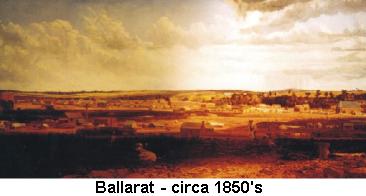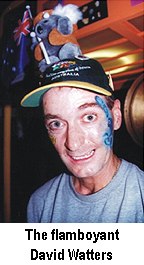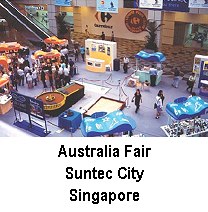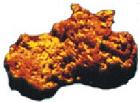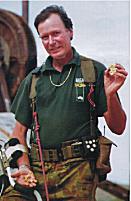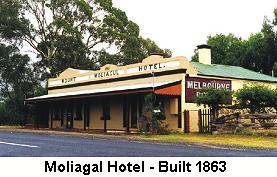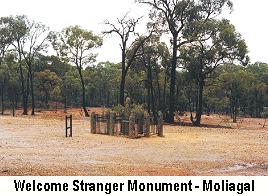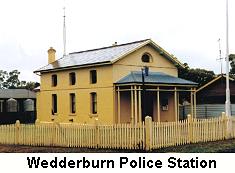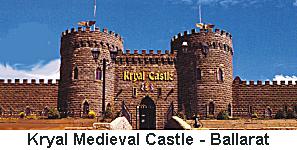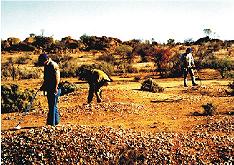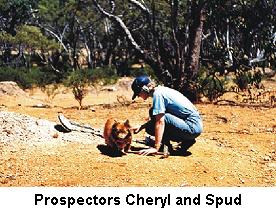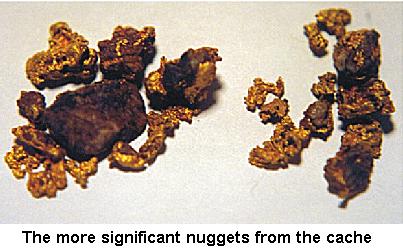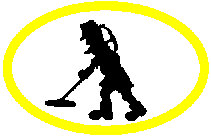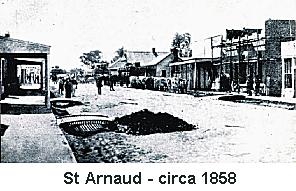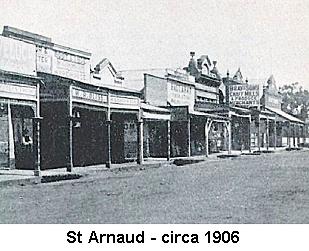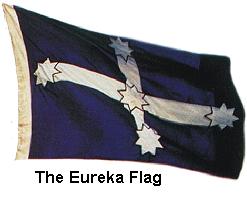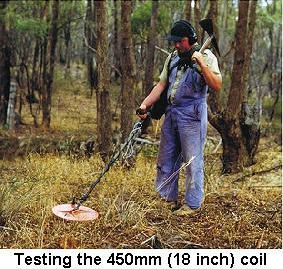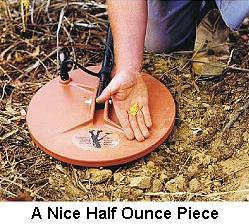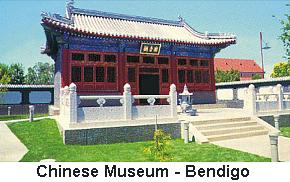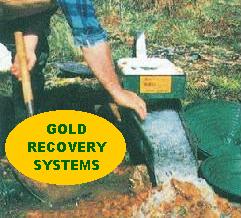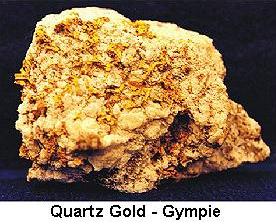
| April 1999 | |||||||||||||||||||||||||||||||||||||||
|
|||||||||||||||||||||||||||||||||||||||
Contents
|
|||||||||||||||||||||||||||||||||||||||
|
|||||||||||||||||||||||||||||||||||||||
| 1. EDITORIAL From time to time technological advances in gold recovery equipment for the privateer creates and stimulates interest and activity in this fascinating industry. New advances in gold recovery equipment are always welcome, and even more so if they are effective. In the past month or so, there has been a renaissance in activity with new coils developed by Coiltek. These coils, a 450mm (18") and a 350mm (14") are recovering some incredibly large nuggets. Beggery Hill at Wedderburn, Victoria, would be among the most "thrashed" ground for detectors in Australia. Once a fabulously rich area for gold in the 1850's, now extensively used as a training ground. Incredibly a 450mm Coiltek coil located a 25-oz. nugget, in this area earlier this month. Other large nuggets are being located with these coils almost daily, in ground that was considered, worked out. As a result of what we were hearing we set out to test these new coils, using the Minelab 2200D metal detector, in itself a proven success story. The coils were developed specifically for the Minelab 2200DD. Combined with the new Coiltek coils, the results were stunning. Serious prospectors per se, are well skilled in assessing new technologies as they appear on the scene. These coils are receiving rave reviews from professional prospectors, and it is well deserved. We include an assessment of these coils in this months magazine. Don't miss it. It makes compelling reading.
Editor Email: [email protected] All material in this magazine is copyright and may not be reproduced in any part or form whatsoever without written permission from the publisher.
|
|||||||||||||||||||||||||||||||||||||||
|
|||||||||||||||||||||||||||||||||||||||
|
2. BONANZA AT BALLARAT by Tom Ferguson Twenty million ounces of gold. A fantastic figure in any language. Wealth beyond dreams. This wealth came from the gold fields of Ballarat, Victoria, Australia. In today's dollar terms around $US 6 billion. Not a bad return at all, if you happened to be one of the many that struck it rich in those fabulous days at Ballarat in the early 1850's. Victoria was a part of the colony of New South Wales up to the early 1850's, when it became an independent colony in its own right. All burgeoning States have growing pains and Victoria was no exception. Rich in agricultural lands early settlers took out sheep runs granted by the government over large tracts of land, where both sheep and some cattle were grazed. Van Diemen's Land to the south, now the State of Tasmania had large penal settlements and the government bureaucracy was both well established and manned. Victoria drew on these reserves in the early years of settlement. The wealth of gold hidden in Central Victoria lay undiscovered for some time and true recognition of the potential was not realized until the finds were widely publicized. Ballarat is an aboriginal name meaning "a good place to rest". An aboriginal tribe known as the Kulin inhabited the area. These inhabitants had dark brown skin rather than black. Although they were the traditional owners of the land, they were simply pushed aside by European settlement, and decimated by disease, poisoning, shootings and in fact genocide. Within 60 years they were no more. The first recorded gold finds in the district was at Clunes, July 1851, some 20 miles north of Ballarat, and this started a small rush. A few weeks later gold was found at Buninyong about 10 miles south of Ballarat. This was poor yielding ground and although diggers came to the area, they quickly dispersed seeking more profitable ground. Two such characters were John Dunlop, a seventy-year-old veteran of the Battle of Waterloo, and a much younger James Regan, whose ancestry was Irish. They had been disappointed with the gold at Buninyong, so decided to prospect the area themselves in anticipation that both Clunes and Buninyong would not be the only gold bearing ground in the district. They were right and after finding gold in creek beds along the White Horse Range on Ballarat Station, they came to a small hill on the northern end of the range and washed the first gold from what was to become one of the great gold bonanza's of all time. The date was 21st August 1851. This hill became known as Poverty Point. (Only because the top of the hill contained no gold) The discovery only remained a secret for about a week, and with news of the gold find the first great gold rush of Victoria had begun. Even in those days news of gold finds travelled fast, and within a few days the area was inundated with no less than 2,500 men all seeking their share of the precious yellow metal. Al least 100 men were arriving daily. With a new find on a hill across the gully at Golden Point, the gold fever reached a crescendo and the area mushroomed into a digging frenzy. Both these areas were exceptionally rich. Within weeks there were 10,000 men at the diggings.
Unbeknown to those diggers, a great wealth lay deeper beneath the surface. By this time miners from the British Isles were arriving. Their expertise lay in tunnelling, and on the almost deserted goldfields at Ballarat they set about digging shafts. At around 100 feet they reached the wash dirt of the old Ordovician bedrock, and many became incredibly rich. With the news the gold fields were resurrected and this started one of the most intense gold rushes of all time. Gold fever ran riot throughout Melbourne. Civil servants abandoned their jobs, businesses were left unattended, and the police force deserted almost to a man. Chaos reigned supreme. With the ground giving up such riches, it was no wonder that men deserted their meagre livings to search for the incredible riches being gathered here. Many small claims just 8 feet square were yielding up to 65 oz. daily from the Eureka lead. One man got 600 oz. in six days. One group washed 480 oz. and got a solid nugget weighing 129 oz. from just 4 buckets of wash dirt. There were three great leads at Ballarat. Firstly the Eureka, second the Gravel Pits and thirdly the Canadian. All of them were great treasure troves. At the Eureka in a deserted shaft a 685-oz nugget was found. Eight men washed 2,400 oz plus 1 cwt. in nuggets. At the Canadian in January 1853, at 60 feet, three nuggets were found weighing 1,619 oz. 1,117 oz. and 1,011 oz. respectively. The Prince Regent lead joined the Canadian and this area became known as the Jewellers' Shops. It was here that one claim 24 feet square yielded one ton of gold. One party here recovered over 1,000 oz in just 6 hours, and after 56 hours their total exceeded 2,900 oz. Bare in mind these figures are the officially recorded yields. No doubt much was removed and not declared. Gold taken from Ballarat to Melbourne under government escort was recorded at almost three million ounces from 1851 - 1856. It would be reasonable to assume then that the gold actually recovered would be in excess of four million ounces. A visit to Ballarat today is a visit to a treasure trove of another type. Magnificent buildings abound. Most are still almost precisely as they were over 100 years ago, and their grandeur is indeed spectacular. Proud of their heritage the city is a progressive and buoyant community, promoting their heritage positively through world class tourist facilities. Ballarat was and now remains, a grand golden place.
|
|||||||||||||||||||||||||||||||||||||||
|
|||||||||||||||||||||||||||||||||||||||
|
3. TRACKLINE IN SINGAPORE Promoting Australian Gold in Asia
Late in 1998, a tourist delegation from Singapore visited Bendigo. The delegates were fascinated with the area. Particular interest was shown in the gold industry, and from this visit the seeds were sewn and an opportunity presented to promote Bendigo as part of the Australia Fair sponsored and supported by Singapore Airlines, at Suntec City, Singapore in March 1999. |
|||||||||||||||||||||||||||||||||||||||
|
|||||||||||||||||||||||||||||||||||||||
|
|||||||||||||||||||||||||||||||||||||||
|
|||||||||||||||||||||||||||||||||||||||
|
4. FAVOURITE SPOTS - THE GOLDEN TRIANGLE by Bill "Nugget" Jones The Golden Triangle of Victoria is by far my most favoured site for metal detecting. It is rare that some gold is not found on each outing, provided one visits the right spots. Wouldn't we all like to do that. In this brief article, I will endeavour to impart some of my knowledge as to some good locations where gold can be found. By no means an extensive assessment of gold bearing ground, but just one prospector's perception of some good areas that I know have borne "fruit" for me in the past. In describing these five areas - take the information for what it is. Gold is where you find it and the best spots for gold today is where the old timers found it last century. After all, that is where it was and that is where it is.
DUNOLLY Travelling north from Dunolly, just on the edge of the town there is a dirt road to the left. Take that road and cross the rail line which is just a few yards in front of you and then turn almost immediately right and follow the rail line towards the north west. Keep the rail line in sight and on your right. This road meanders along for quite some time, and slowly moves away from the train line. About 2km along this road is where I recommend you stop. It is pretty open country here with not much ground cover, and the old diggings are sparse, but they are there. In front of you and to your left, there should be a gully. This is known as Mackintosh's Gully, and I have always found gold here. Further to your left there are other gullies, including Nuggety Gully, but stick to the gullies that show signs of diggings. On the slopes among the rocks you should be able to find your share of the grand old yellow stuff.
Never the less, although you will be frustrated at the amount of rubbish in the ground it is a top site for good targets, and good gold can always be got here. Just remember it will be hard work sorting the "wheat from the chaff". Just north of Inglewood on the Calder highway where the State forest starts there are a couple of tracks off to the right that leave into the bush. They are rough bush tracks. There is no need to go down these tracks, as there is good gold right alongside the Calder. Now as I have said, the bush is pretty thick here, and it isn't going to be easy getting the targets out. Not really the country for 18" detectors either. No doubt you will find yourself using a few choice adjectives as your gear gets caught up and the bushes scratch your face, but persevere here, as this is where the best gold is. Hard to get at, but it is there, in good quantities and some of the sizes are pretty good as well. If this is a little too tedious for you, step across the road. Cross the railway line and keeping the rail line in site detect here. It's a little more open on this side. Not as much gold, but still quite a few pieces can be picked up. Last time I was here in the middle of the bushes, I caught my pick on a branch as I was swinging it down, and it ricocheted backwards out of my hands and almost landed on the Calder Highway. My two mates haven't let me live that one down yet, but I guess that is just part of being out here and having a good time. Oh yes, that target turned out to be a nice little nugget. I had the last laugh that time.
WEDDERBURN
ST. ARNAUD Closer to Stuart Mill, there is a track off to the right, sign posted Rostron. Take this track and on the right a few miles down a creek begins to run alongside the road, on the right. Shortly after the diggings begin. There were lots of Chinese here on these diggings, so some relics can be expected on these diggings, however if you back up about half a mile there is a track off to the left. Take this track and stop after about half a mile. Right throughout this gully you will find extensive diggings, well spread out and following not only the creek line, but diggings on the slopes as well. Although the gold is somewhat sparse here, a good day detecting here should be most rewarding. Most of the gold in and around Stuart Mill was at some depth, and usually in quartz, but the locations described are all surfacing locations, and gold can be found, if your lucky.
All of the sites described are very easy to locate and can be readily accessed by a two-wheel drive motor vehicle. Additionally, the gold from these regions was surface gold. Good prospectors are often criticized for working old ground. Well I guess they do that because that is where the gold is.
Never overlook old diggings. Gold is still left in most of them. You just have to be good enough to find it. Next time we'll look with more depth. Perhaps some locked away remote places. However, don't expect me to give away all my secrets. I am still a prospector you know. |
|||||||||||||||||||||||||||||||||||||||
|
|||||||||||||||||||||||||||||||||||||||
|
|||||||||||||||||||||||||||||||||||||||
|
|||||||||||||||||||||||||||||||||||||||
|
5. THE LEGEND OF LASSETER - Part 2 Craig Wilson Harold Lasseter at last had the ear of an influential person. He was in the Sydney office of John Bailey, the powerful President of the Australian Workers Union, and Bailey was listening intently. Lasseter was in his element. He related how he had found his fabulous reef and lost it again, and had returned with Harding and re-located it. At the conclusion of the meeting Bailey promised nothing. He did however, make his own inquiries and found a great deal of truth in what Lasseter was telling him. Bailey was influential, and within a few weeks a company was floated with a paid up capital of 5,000 pounds. These were hard times in Australia. The great depression had more than made its impact in 1929, and raising capital at all in 1930 was no mean feat. What prompted Lasseter to approach Bailey is open to conjecture, but it is clear he had some affiliations with the union movement, which may have been beneficial. The object of the expedition organized by the company was to locate Lasseter's Reef, search for other minerals, and identify new country suitable for stock grazing purposes. This would be achieved by a minimal ground party travelling by truck from Alice Springs, supported by an aircraft to survey the vast country. The idea seemed quite practical, but perceived practicalities and reality were another matter. Lasseter's role in this expedition was to act as guide, with Fred Blakeley the leader. George Sutherland, a prospector and miner, Phillip Taylor and engineer, Captain Blakiston-Houston, explorer and E.H. Coote, the pilot. The truck named the Thornycroft" was railed to Broken Hill, and from there Lasseter drove it overland to Alice Springs. In due course the expedition members gathered together at Alice Springs and preparations were made for their adventure. They learnt that a week before another expedition had left Alice Springs in search of the reef, and there were rumours of yet another en route from Western Australia. Lasseter was not concerned. A second truck was found and well equipped. With over 3 tons of fuel and 2 tons of provisions they were well prepared for their trip. On the morning of July 21st 1930, in great heart they set out west from Alice Springs on their great adventure. After two days they had made 80 miles across open country and camped the second night at Hamilton Downs Station. While camped here the party acquired the services of a black boy called "Mickey". A fairly intelligent fellow, who was experienced with white mans ways. This was Mickey's country. He knew the country well, and would guide the party to waterholes. Ilbilba was their chosen destination, and as they travelled west the country grew more forbidding and the going became harder. Ilbilba was a favourite camping spot for the local indigenous people, as there was permanent water there. En route however, the water supply was not so assured, and the party had difficulty locating the water holes Mickey was supposed to know. For the next few days as they travelled west, the going was very hard indeed. Matting was laid to stop the trucks sinking into the soft sand. They would make a few yards stop, and bring the matting forward again, placing it under the front wheels again and then proceeding a few more yards. The going was slow, laborious, and wearing on machine and man. Eventually the smaller truck stripped a pinion while crossing Taylor's Creek, and the group decided to clear part of this dry creek bed as a landing strip for the plane. While the pinion was being repaired, the pilot would return to Alice Springs to collect his bi-plane and bring it forward. After some strenuous days clearing a landing path, a drone was heard over head and Coote landed safely on the creek bed. Mickey had not seen a plane before and his large eyes almost popped from his head with this big bird landed and the pilot alighted. He was fascinated with the contraption. The aircraft was serviced, securely tied down. They pressed onwards, ever westwards, and with great difficulty as the terrain became harder. One afternoon the party broke through into open ground and a large sand hill appeared with a solitary tree atop. Blakeley ordered Mickey to its top to reconnoiter the area, but Mickey sternly refused. "Kaditcha" murmured Mickey. This was sacred ground. Ground so sacred that death was certain if the area was violated. White men had seen this fear before, and had seen deaths from transgressors. The party struggled to understand the culture that was so strong in Mickey's commitment to avoid the area. The inborn power of superstitions within the indigenous communities is intense and rarely comprehended by white man. Even today deaths can and do occur from these intense beliefs. Be they superstitions or not, the intensity of the beliefs are without question entirely genuine. A further week of travelling west revealed much. Wild brumbies (horses) abounded, as did other wild life. The going was tough and painfully slow. Only 2 miles an hour for the last 70 miles had been got. The trucks were overheating and the exhaust pipes were so hot a fire was started in the dry grass. Fortunately quick action saved the day, but it was a sobering moment. Ilbilba was reached. A large open plain quite suitable for an aircraft to land in any direction. The activity of the party had not gone un-noticed. From the surrounding hills small plumes of smoke rose in a circle around the party. Suddenly in the distance two tall black figures stood together motionless. Each holding barbed spears in their hands pointing to the sky. They were intensely black, well proportioned and obviously of some standing within their communities. Blakeley made peaceful overtures and eventually the black men cautiously approached. Recognizing the intentions of the whites were peaceful, they relaxed somewhat. Mickey, was of little use in interpreting, as his language was completely foreign to the "Myall" men and he could not understand them. In due course, more blacks appeared. The lubra's (women) with their naked piccaninnies (children), became bolder and soon their boldness was of some concern to Blakeley. Once the area was secured, the auxiliary truck was to return to Taylor's Creek with the pilot Coote, and the plane would be brought forward to Ilbilba. The return journey to Taylor's Creek was accomplished without incident, but upon arrival there, it was decided that a longer runway was desirable. This was quickly cleared, and the plane prepared for take off. The motor was gunned and the craft gained speed quickly. With the engine roaring the bi-plane lifted graciously into the air, and was soon at the top of the mulga trees. Disaster struck. The engine spluttered and stopped at the most critical time of take off. Coote was committed, and looked intently for a safe place to bring the bi-plane back to the ground safely. All that was ahead of him was scrubby trees, and the aircraft smashed into the ground and flipped onto its back.
|
|||||||||||||||||||||||||||||||||||||||
|
|||||||||||||||||||||||||||||||||||||||
|
|||||||||||||||||||||||||||||||||||||||
|
|||||||||||||||||||||||||||||||||||||||
|
6. VISITING AUSTRALIA Robert Read
Victoria is the smallest of the mainland States of Australia. The capital, Melbourne is one of the great cities of the world. 
Travelling to Australia may take a little longer than to other destinations in the world, but armed with the knowledge that Qantas, Australia's international airline is the safest airline in the world, that extra time is of no real consequence. Upon arrival the choice of accommodation facilities is extensive. From 5 star international hotels, to tents in the bush, the facilities are indeed world class. Perhaps the greatest advantage is that within 30 minutes of the airport gold seekers can be in the golden triangle and detecting for gold. Automobile hire rates are very competitive, but just remember it's the left side of the road over here, if you're from North America. From the earliest gold discoveries in Victoria, most of the auriferous surface areas have remained within State Forests Reserves, and these are extensive. Almost 30% of the entire State is Forest Reserve, and most of this covers extensive gold bearing areas. Known within Australia as the "Garden State" Victoria indeed lives up to that reputation. With prominent winter rainfall the State is by Australian standards one of our most productive rural areas. Within the golden triangle both Bendigo and Ballarat are major rural cities. Each with a population approaching 70,000 they are indeed sophisticated rural entities, boasting a host of facilities for tourist orientated activities. Just take a look at www.ballarat.com and www.bendigo.vic.gov.au/ They are both enlightening sites and provide an insight into these two exciting rural cities, whose history is drenched in gold.
Try the delightful Bed & Breakfast facilities of Brim Brim Lodge http://www.ballarat.net.au/B&Bstay and Tranquillity Serenity Centre, Email: [email protected] both quality facilities. Bendigo and Ballarat are about 80 miles apart and between them the number of smaller towns and villages abound. The two largest being Maryborough and Castlemaine. Vibrant rural communities of around 15,000 people. Interspersed throughout this region are smaller towns and villages. Some are sleepy little places, with many of the buildings erected from the mid 1800's still standing in all their former glory. Perhaps a little tarnished, but the entire golden triangle abounds with many such buildings, undoubtedly reflecting a bygone era of great prosperity. Almost in the middle of the golden triangle lies the Pyrenees. Australia's Pyrenees that is. A small enchanting low mountain range, that hide a myriad of rural activities, including a number of very fine wineries, and rural bed and breakfast facilities. Not quite like the Pyrenees between France and Spain, but never the less a quaint and delightfully enticing area, that draws one back, time and time again to this captivating place. I rather like this area, as there is a lot of gold in "Them there hills", just waiting for a metal detector to slide over it. Tourist facilities throughout this region cater well for gold enthusiasts. Metal detectors can be hired from a number of outlets, and motels and caravan parks provide excellent accommodation at very low rates. Double accommodation is readily available from $US30-$40 per night in self contained motels, and the local "pub" (hotel) in these smaller towns and villages offer an in depth insight into the Australian character and psyche. One will always find a 'character' or two in the front bar, who will entertain and amuse a visitor with colourful disdain, but always in a friendly way. Just take note that the Aussie is a great one for playing practical jokes on visitors, in a lighthearted way. No offence would ever be meant. There are a number of professional prospectors who for a moderate fee will host visitors throughout this area. Most have access to private ground and the likelihood of finding gold with a professional is greatly enhanced using their knowledge and expertise, which I might add, is freely given.
Perhaps the greatest asset in coming to Australia is the fact that visitors from all over the world are welcomed. One of the safest places on earth, North American and European visitors immediately feel the warmth and generosity of this inviting country. You will be both enthralled and delighted with your trip "down under". Look me up when you get here.
|
|||||||||||||||||||||||||||||||||||||||
|
|||||||||||||||||||||||||||||||||||||||
|
|||||||||||||||||||||||||||||||||||||||
|
|||||||||||||||||||||||||||||||||||||||
|
7. THE LOST CHINESE VILLAGE by Jim Foster G old in great quantities was found throughout the State of Victoria, Australia. One gold field, on the western edge of the fabled Golden Triangle, was of particular interest to us. The Pyrenees ranges runs roughly north-west, a softer, more gentle range than some, its tree covered ridges and gullies yielded tons of gold to the hordes of prospectors who swarmed these slopes in the eighteen hundreds. We liked the Pyrenees because they were reasonably close to home and always seemed to yield some gold to our Minelab made gold detectors. Couple those attractions with the beauty of the place, the myriad wildlife and colourful flora and you can see why we are attracted back there time and again. In the tiny towns sheltering on the eastern edge of the range we heard of the legend of the lost Chinese village. In a country whose history only spans two centuries a story such as this is rare as rocking horse poo so we began making inquiries. It turned out that the last person to see this village, a timber getter, had died some years before but had told his family of his find. In the eighteen sixties, when gold laden gullies were still being discovered, a group of Chinese miners found a rich gully amongst the tall iron-bark trees that cloaked the hills and gullies back in the ranges. The gold was easy to get and covered a fairly large area they set about building themselves suitable accommodation. This eventually turned into a substantial little village. It had, the old timer said, constructed pathways between well built huts, drainage ditches and the remains of a large vegetable garden that had once been irrigated with water directed from a dam on a nearby gully. It had, he said, all the appearance of being inhabited for several years before being abandoned when the gold ran out. We spoke to one of the National Parks Rangers who knew the country better than anyone, but though he'd heard the story even he didn't know where to find this lost village. By now we were thoroughly intrigued. What could be found in a lost Chinese village with the first gold detector to detect the ground? Visions of rare Chinese coins, hoards of gold nuggets, and numerous interesting artefacts flashed through our minds, but just to be the first people to document such a find would be a fantastic thrill. We decided to search for this Eldorado of the Pyrenees whenever time allowed. For the next few years we searched far and wide through those mountains. We found many a hidden gully carrying signs of gold being found there, and we found some ourselves. We even found numerous round Chinese gold diggings amongst the rectangular shafts dug by European miners but the lost Chinese village eluded us. Not that we'd spent much time specifically looking for it, just kept our eyes open for what we had decided would give it away. The village would of course no longer exist as such. The many fires that rage through these parts on a regular basis would almost certainly have burnt it to the ground. This was our reasoning for it not being found before. It would no longer be recognizable as a ruined village. But certain clues would give it away. The mining activity spread over several years would leave a substantial area of diggings that would be easily recognizable. These diggings would be only of the round shaft Chinese variety. They would be shallow with evidence of surfacing as well as shafts. Of the buildings there would remain at least the fireplaces, usually made from locally collected slate. The paths and drains would be overgrown but easily seen by someone who was looking for them. Europeans carried mainly ferrous metal objects that were lost or discarded, to be left to rust away. Chinese miners used mainly non-ferrous metal because it was softer and easier to work. Much of the discarded Chinese rubbish would also carry writing in the form of Chinese characters. Our detectors could tell the difference between ferrous and non-ferrous so if the latter metal rubbish predominated it would be a signal to look closer. We thought that should we stumble on the diggings we would recognize them and easily find the village, all it would take was to continue to search out gullies that had once been worked for gold. It wasn't until a couple of years ago we thought we'd found something. Walking a gully looking for sign we came to the top without finding anything and crossed a ridge onto another gully. This gully was different. The trees were taller and straighter, indicating water not very deep down. And there were Chinese diggings everywhere. Checking around I found the remains of an old campsite. Just the outline of the walls could be seen with a mound of flat rocks at one end indicating the fireplace. I checked the ground in and around the confines of the walls and found many ferrous signals. Nothing of value is made from ferrous metal so I didn't dig them. Then I checked the fireplace - a favourite place for the old-timers to hide things. There were the usual rubbish signals that we'd come to expect from old fireplaces, rusty nails, bits of tin and such, but then I found a good strong signal just in front of the fireplace. It was a large signal, one like we had often heard from a large bit of zinc plating the like of which was often used in old meat safes. But a good signal should never be ignored.
Driving my digger into the ground I scraped away the accumulated dirt from a large piece of slate. It looked as if this had been used as a hearth. Running the search coil over the slate I heard the signal increase in volume but still retain the mellow sound that non-ferrous metals make. Now this was interesting, the signal was coming from under the slate. With growing excitement I called Cheryl over to share in the find.
Excitement bubbled through me as I rubbed dirt from the nugget before passing it to an impatiently reaching Cheryl. While Cheryl cleaned and admired the nugget I looked for more. Again I swung the search coil over the hole. The signal was undiminished signifying more gold. Carefully I scraped out two more nuggets. Then a small pile of fine gold, mixed with scraps of leather, came out on the blade of the digger. We both gave whoops of delight; we knew we'd found a miner's cache.
What happened to the old-time gold digger who hid his gold under the slate we can only speculate. He wouldn't have just forgotten it. Perhaps his bones lay buried down a nearby shaft, crushed under a cave-in. These workings were wet and therefore dangerous ground to work. He could have died of snake bite or thirst, or he could have been murdered by the marauding bush rangers that stalked diggers in this part of the country in those days. But what ever happened to him he left his gold behind for us to find.
It turned out that gully wasn't the Lost Chinese Village, but we still visit those ranges and search for gold. One day we will find it, explore it, map it, and search it for the gold it holds, then we'll let you know where it is. |
|||||||||||||||||||||||||||||||||||||||
|
|||||||||||||||||||||||||||||||||||||||
8. FLECKS ! - Glints from here and there
|
|||||||||||||||||||||||||||||||||||||||
|
|||||||||||||||||||||||||||||||||||||||
|
|||||||||||||||||||||||||||||||||||||||
|
|||||||||||||||||||||||||||||||||||||||
|
9. ST. ARNAUD GOLD by katherine Knight The small rural township of St. Arnaud settles neatly into the northern end of the Pyrenees, about 60 miles west of Bendigo, Victoria. It is a sleepy little town on the edge of Victoria's Golden Triangle. However, the contribution it made to the gold bonanza of the time was significant. Although some settlement was evident prior to the 1850's, supporting the sheep runs, it took a party of gold prospectors to accelerate the human tide that swamped the area, and eventually grew into this quaint rural town. The area of St. Arnaud and later the town, was named after a French Marshal, Jacques Henry De St. Arnaud, who was a prominent general in the Crimean War, which was fought from 1854-56. The allies were eventually victorious and several streets in the town are named after British General's of that campaign. Eight young men, mostly from the British Isles set out in 1854, to prospect for gold near Avoca. After several weeks without success, the group split into two. One group remained in the Avoca area, while the other four made their way to the north, in search of auriferous ground.
They were prospecting in ever increasing circles around the main camp when, in mid January 1855, they these four young men struck a rich patch of gold that was to change their lives forever. Because the gold was so plentiful, they called the area "New Bendigo", after the massive gold finds that came from Bendigo a few years before. Keeping the find secret was another matter. Although their find was about 4 miles from the main camp, they remained by the creek. For two months they worked diligently extracting what they could without arousing suspicion. During this period, members of the group located the Gap Reef, and the Wilson's Hill Reef, which they covered to work at a later time. Keeping such a find secret was an awesome task, and some gold was taken to Avoca for sale, to fresh supplies could be maintained. One member dressing in old worn and tattered clothing and being accompanied by an urchin who carried the gold sewn inside his tattered clothes. This methodology enabled them to escape the attention of the many bushrangers who preyed on unsuspecting diggers throughout the gold fields. Try as they might the secret was kept for only about two months, and by October 1855, the area had been swamped with diggers, and their families. Records indicate massive discrepancies in the numbers who came to the "New Bendigo" rush. Some reported up to 20,000, but the papers stated that the figure was more like 3-5,000. It is likely that large numbers initially came, surveyed the situation, and many quickly moved on. Perhaps for a week the numbers reached near 20,000 but in the main the average population was in the vicinity of 5,000. The "New Bendigo" rush was not the bonanza many had thought it was going to be. In fact the entire gold field only extended over about 40 acres, and not much of that was on the surface. Understandable then that many came, saw, assessed, and left. Experienced miners however were considering the quartz that was abundant in the area, and many claims were lodged where the quartz broke through to the surface. Perhaps those that reaped the most financial benefit from this rush were the traders. Many with extensive experience and with accrued business skills, they would set up shop in the most prominent position that could be found and sell their wares at inflated prices to those who were passing. Smart operators paired up, and while one managed the shop, the other joined the diggers and reaped rewards from both business ventures. The diggers did not travel alone to the new diggings. They were always accompanied by the usual bands of bushrangers and villains that preyed on the unwary. One group of four felons held up and robbed no less than 17 people within three hours near St. Arnaud. After this they rode to a nearby encampment and presenting firearms held up and robbed all present of their valuables. One of them asked a young woman a question and when she replied was shot in the chest for her trouble, and she died almost immediately. From this time on the diggers were merciless in their treatment of bushrangers at these diggings. When two bushrangers were captured they were so badly knocked about that they both died from their injuries. Justice in such remote and lawless places was indeed swift and merciless at times. By the end of 1855 three quartz reefs were bring worked. The Gap, Shewring's and Wilson's Hill. These reefs produced some quality nuggets with one of the largest being 320 oz. Other nuggets of 120 oz. and 100 oz. were located, but records of other finds indicate most of the gold was got in small pieces, up to 4-5 oz to the ton. By late 1857 there were less than 200 people on the field. Through the blazing Australian summers water was scarce, and during winter the Avoca River was prone to flooding. There was never a medium situation that satisfied the diggers needs. Either too much water or none at all. The diggings were well away from the creeks and rivers in any case and there were easier gold fields to work in the area.
St. Arnaud today is a quaint country village of just under 3,000 people.
Many of the original buildings remain practically as they were over a century ago. The main street in particular displays a unique insight into the golden past of St. Arnaud.
|
|||||||||||||||||||||||||||||||||||||||
|
|||||||||||||||||||||||||||||||||||||||
|
10. BATTLE AT BALLARAT - Part 3 by Craig Wilson Governor Hotham's decree that mining licenses were to be inspected and the law enforced rigidly did not sit well with the diggers. They had expected relief from this man, but it was now abundantly evident that sterner measures would need to be taken to bring a fairer system of administration to the gold fields in Victoria. Peter Lalor, along with a number of other concerned diggers, met secretly to discuss and plan a course of action. Most meetings were somewhat ad hoc and the cultural diversity of the diggings created divisions among the various races that proved difficult to overcome and mould a united and cohesive body that could properly address the problems at hand. The catalyst eventually came in the murder of a digger on the gold fields. Jim Scobie, a Scot, in company with Jimmy Martin, had become drunk one evening and had ended up outside Bentley's Hotel, at a very late hour. They were on their way home, and seeing a light on, bashed on the door asking for liquor. Bentley, his wife and the Police Magistrate John D'Ewes were inside drinking. The door banging continued for a few minutes and then the sound of broken glass. Bentley had a reputation for brutality and was well known to have bashed a number of diggers in a violent manner. In company with his wife and two others Bentley went to the door of the hotel but found nothing. The two drunks had wandered off into the darkness. A noise was heard away from the hotel, and the group who had gone to investigate made their way towards this noise, and discovering the two drunken diggers, set about assailing them in a vicious manner. Both Scobie and Martin were so drunk they could not defend themselves, and after receiving a bashing with fists and boots, Martin crawled away leaving his friend Scobie fending off a hail of fists and boots. Martin awoke later that morning to the news that his friend Scobie had been done to death at the Eureka Hotel. The diggers had strong suspicions as to who the murderer was. Bentley was the prime suspect. At the inquest on the following Monday, the evidence presented was minimal and the jury returned an open verdict. There was stunned silence in the Courtroom. Peter Lalor, who had been present at the inquest, discussed the matter with others and after returning home there followed a knock on his door. He was surprised to see the jury foreman standing before him. The foreman considered that the Coroner had misdirected the jury and no less than 9 of the 12 jurymen were prepared to sign a letter stating that as fact. Lalor acted quickly, in having the letter written and signed by the jurymen, which he then produced to Commissioner Rede. Robert Rede was an astute administrator, and recognised he was obliged to act following receipt of the letter. A warrant for the arrest of James Bentley on a charge of murder was issued. A few days later a preliminary hearing was held before the Police Magistrate John D'Ewes, supported by Commissioner Rede and Assistant Commissioner Johnstone. The examination was a farce from beginning to end, with D'Ewes acting with disdain and supporting Bentley in every way he could. The charge was dismissed and D'Ewes words at the conclusion of the examination supporting Bentley were so inflammatory that they were to ignite the simmering powder keg at Ballarat. That evening, a meeting was held at the Star Hotel among the leaders of the various groups. It was unanimously decided to hold a public meeting on the next Tuesday the 17th October near the Eureka Hotel, near the spot where Scobie had met his death. Bentley expressed concern and sought protection from authorities, which was denied.
Five thousand diggers attended the meeting, and the mood was sombre with an under current of volatility evident. Extra police and mounted troopers were on hand. Speakers included Peter Lalor, and it was his suggestion that a subscription be called for to post a reward for the murderers of Scobie.
Commissioner Rede arrived and assessing the situation to be grave, ordered the Riot Act to be read. This was an Act of the British Parliament dating back to George 1st. It provided for riotous assembly to be deemed a felony, once the Riot Act had been read in the presence of the rioters. The Act was read aloud but to no avail. The attack on the hotel by the seething mass of enraged diggers continued. Fire was now taking hold and as it grew in intensity the mob backed away and watched as the hotel burnt to the ground. Commissioner Rede witnessing the occasion considered his options. Such behaviour could not be tolerated and the rule of law had to be re-established. His intentions were clear. Two men who had taken part in the arson were arrested and placed under heavy guard in the government camp. They were refused bail, and a mob gathered on Bakery Hill, again numbering almost 5,000. Some wanted to rush the government camp and release them, but when Lalor spoke his advice was accepted. He suggested that a deputation be sent to the government camp with a request that the two prisoners be allowed bail . Police Commissioner McMahon, a levelheaded Irishman, was at the camp by this time and met the deputation. Following representations the two prisoners were allowed bail. A massive meeting of diggers followed. Some 15,000 gathered on Bakery Hill to provide support for their charged mates. They were intent on defending them vigorously before the Courts. The meeting was orderly and the diggers dispersed peacefully. The mood opposing the oppressive government administration on the goldfields was rapidly gaining momentum.
|
|||||||||||||||||||||||||||||||||||||||
|
|||||||||||||||||||||||||||||||||||||||
|
11. STRIKES Recent Finds
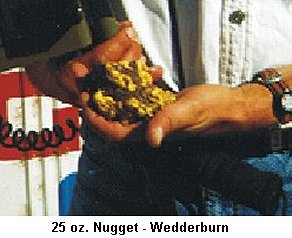
|
|||||||||||||||||||||||||||||||||||||||
|
|||||||||||||||||||||||||||||||||||||||
|
|||||||||||||||||||||||||||||||||||||||
|
|||||||||||||||||||||||||||||||||||||||
|
12. COILTEK REVIEW A Magic Marriage We had been hearing good reports about a new coil that was being produced by Coiltek, the small South Australian company that had been producing coils for Minelab, for their successful range of metal detectors. Both John Kah and John Gladdis of Coiltek were most helpful in providing us with information about the new coils, so last weekend we set off with a couple of these new coils to try them out in the Victorian goldfields. Both the 450mm (18") and the 350mm (14") coils were tested. Now before we proceed much further, lets set the perimeters for what we sought to do in this test. It should be recognized that this is only an opinion of two experienced metal detector enthusiasts, albeit if we have at times been professional prospectors. Take what we say as being from one prospector to another, with an honest assessment of what we found.
We didn't expect to find much at all in the time we had, and took a few pieces of small gold with us to test the depth of each coil. The coils themselves are reasonably light for their size, although it could be said they are not feather light. That is one of the prices that must be paid for depth with larger coils. The bigger the coil the heavier it is going to be, and that must be weighed against the amount of gold that one could reasonably expect from a larger coil. As we found out, the weight was well worth while. Developed specifically for use with the Minelab SD 2200D detector, we found the effectiveness and depth of these coils were best suited to the 2200. They work well with both the Minelab SD 2100 and 2000 detectors, but the results with the SD 2200D were outstanding. We firstly tried both coils over small gold pieces buried in about 6" of loose dirt. Both coils gave a good signal even with the gold on edge. The larger coil giving a more prolonged sound that required concentration to recognize. That was to be expected with a coil of this size. While I was setting up these "experiments" Michael was testing the 350mm (14") in the vicinity. Amazingly he got a clear signal not 10 feet from where I was scratching about in the ground, and digging it up, he found a nice half ounce piece, much to his surprise. It was about 12" deep, and a good signal was relayed.
Next we tried the coils on a well-used Minelab SD2100D. This was Michael's detector and with the knowledge of his own machine, was able to make a better assessment, using these coils. When tested over known targets both gave similar results to the SD2200D, and located the gold, but a clearer signal was evident using the SD2200D. This was very obvious indeed. We tried a number of combinations, depths, and buried small gold over a foot deep in heavy mineralized ground. We continued to bury deeper until the signal no longer responded. What became evident was that although the coils worked well with the Minelab SD2100, the results with the Minelab SD2200D excelled. Our tests could not be in any way be described as scientific, but they gave us a good idea of the capabilities of these coils using different detectors. Quite clearly, in our opinion, if you are going to embrace these coils, do so with the SD2200DD. You won't be disappointed. We wrapped up our somewhat primitive testing of these coils and took the opportunity to talk to some of the agents in the Victorian Gold fields about the results others were experiencing with these new coils. We heard of a 25-ounce nugget that was found at Beggery Hill, near Wedderburn, in what is well known locally as country that has been thoroughly worked and worked. This was found using the Minelab SD2200D with a 450mm Coiltek coil. From all reports the signal was described as strong and obvious. We obtained a photograph of this nugget and it can be seen in this issue under "Strikes". An 8-ounce nugget has also been recovered from Queens Gully at Wedderburn, and this too was in ground that has been well worked. The finder was using the 450mm Coiltek coil. We also confirmed that the 78 oz nugget take from the Pilbara in Western Australia was found with a Minelab SD2200D with the 450mm coil. It is our view that these coils are well worth the effort to the serious prospector. For the best results, use of a Minelab SD 2200D is highly recommended, but good results can be achieved with both the SD2100 and 2000.
When we returned the coils to Coiltek, I noticed a protoytpe of a 600mm (24") coil, and a small elliptical coil tucked away from prying eyes. These two products are presently under test and will be released shortly. I just can't wait to get hold of the 600mm coil and give that a good workout. Just looking at that size makes the mind boggle. Finally, yes, we have both placed orders with Coiltek for their coils.
|
|||||||||||||||||||||||||||||||||||||||
|
|||||||||||||||||||||||||||||||||||||||
|
WE BUY GOLD GOOD QUALITY NUGGETS REQUIRED TOP PRICES PAID Currently seeking half ounce nuggets and upwards. Gold nuggets sold on consignment 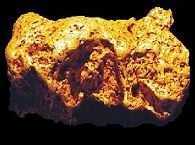
PO Box 258, TANUNDA. SA. 5352 Telephone: (08) 8563 0097 Mobile: 0417 848 910 E-mail: [email protected] |
|||||||||||||||||||||||||||||||||||||||
|
|||||||||||||||||||||||||||||||||||||||
|
13. THE CHINESE CONNECTION by Sue "Goldie" Reynolds The Chinese are well known for their industrious prowess. When word of gold strikes in Australia appeared in their local papers in the 1850's there were large numbers who chose to try their luck in this great vast land to the south. The vast numbers of Chinese who eventually came to the Victorian gold rushes were of concern to authorities. Little concern was shown towards Caucasians who came from all over the world, readily welcomed to the new colony. The Chinese visitors, on the other hand, were another matter. The voluminous number of arrivals of these industrious people needed to be curbed, or so the administration of the day proclaimed. A ten pound tax would be imposed on any Chinese landing in Victoria. This was designed to reduce the numbers arriving. The administration had not reckoned with the tenacity and ingenuity of the Chinese. If it was going to cost ten pound to land in Victoria, they would simply land somewhere else where they were not in Victoria. Consequently, Robe in South Australia became a favourite port of call for ships with their Chinese cargoes. It should be recognized that the Chinese were not considered "men", and ships manifests would state that the ship was carrying 40 men and 700 Chinese, as though they were cargo or livestock. From Robe they began the trip overland to the Victorian goldfields, trekking all the way carrying their possessions with them. It must have been an arduous journey as many perished in the wilderness as they moved relentlessly east towards the great gold fields of Australia in Central Victoria. The trip was at least 200 miles, and although over flat land, the bush was exceptionally thick in some areas. Some ships disgorged up to 1,000 Chinese at Robe, and what a sight it must have been in the 1850's to come across such large numbers, all dressed in native garb trekking through the Australian bush. Each carrying loads of up to 200 pounds, with their buckets, tools, cast iron stoves etc. on long bamboo poles. Historians throughout the world are presently researching the history of the Chinese on the Australian goldfields. Although government records were kept and surveys taken, it is clear that the contribution made, particularly throughout Victoria has, for almost 150 years, been essentially ignored. The Chinese like others on the goldfields relocated from place to place when rushes occurred. From 1855 onwards, the contribution made by the Chinese in this country was significant. Although they kept to themselves and in the main settled their own disputes, they were persecuted because they were Chinese. The influence of the Chinese can still be seen throughout the goldfields area. In Ararat, where there was a substantial Chinese population on the goldfields and here there was a greater acceptance of these people than in other places. They were responsible for the Canton Lead an extremely rich lode of gold. Wat A Che was a remarkable character. He was popular with the Caucasian diggers in Ararat and was very involved in community affairs. Raising funds for the under privileged, bringing in Chinese doctors who treated all comers, and commencing the district hospital. In Ararat there are still several buildings with Chinese architecture displayed. A visit to cemeteries throughout the goldfields in Victoria reveals a great deal of the real history of the Chinese. In Bendigo and district cemeteries there are well over 2,000 Chinese buried. In Ballarat there are similar numbers, and a good percentage in Ararat. Although assimilation was not acknowledged, far more familiarization occurred than was admitted. There are a number of examples of Caucasian women living with and in fact being married to Chinese men. The resultant children were given anglicized names to protect them from persecution. The Bendigo Historical Society has recently discovered at least 40 such children. This was not confined to just Bendigo.
In Bendigo there is a fine museum, the "Golden Dragon" reflecting the bygone influence of the Chinese, and in Ararat there is a renewal in the Chinese culture that is culminating in a new Chinese centre in this old gold town.
The influence of the Chinese lingers today. It is proudly acknowledged and is being resurrected for all to see.
|
|||||||||||||||||||||||||||||||||||||||
|
|||||||||||||||||||||||||||||||||||||||
|
|||||||||||||||||||||||||||||||||||||||
|
|||||||||||||||||||||||||||||||||||||||
|
14. GYMPIE GOLD by Graham Sargood Recently Gympie in South Eastern Queensland suffered the ignominity of one of Australia's great contrasts. A massive 100-year flood inundated the town and most of the main street disappeared under a torrent of water. By disappeared I mean actually that, as only the roofs could be seen on the shops. Such are the contrasts in Australia. Gympie,is an unusual name and the origins are aboriginal. The area has an abundance of a nettle tree throughout the region, and brushing against this tree's foliage causes considerable irritation to the skin. The local black people knew this and named the nettle tree Gympi, meaning "devil devil". Queensland became a State in it's own right in 1859. The population was just 23,000. A few years late the fledgling State was on the verge of bankruptcy. The geography of the region is harsh, with crushing droughts for years at a time, followed by flooding rains than can inundate the country for months at a time. In the early years of Statehood Queensland was in the grip of a drought. Crops had failed and wool, beef and other rural activities had suffered terribly as a result of the crippling drought. Unemployment was rife and the State in general was in a desperate state. The area of Gympie was about to resurrect and rescue the State from bankruptcy. The discovery of gold in this area is credited to an English immigrant, James Nash. He was searching for gold along the creeks in the region and stopping along Gympie Creek he found traces of gold in his first pan. He found several small nuggets and after gaining more stores at Maryborough Queensland, he returned and found 75 oz. in 6 days. After securing as much gold as he could without being discovered, he made his way back to Maryborough and declared the find. The Gympie gold rush commenced in earnest. Within 6 months more than 10,000 were in the area. Although the Government had posted a reward for the first major gold field found in the area in the sum of three thousand pounds, Nash lonely received one thousand pounds. Like the Victorian gold rushes many merchants set up stores in the most obvious places to catch the passing trade. The main street today bears the marks of those early days, and is about as straight as a clinging vine travelling up a trellis. The gold field was rich in surface gold and good size nuggets abounded. The largest was reputed to be 975 oz. This came from one of several "Jeweller's Shops" that were found in the area. Some of these were returning up to 1,000 oz to the ton. Fabulous wealth indeed. Most of the gold was transported to Maryborough, but as was the usual practice the figures do not reflect the true value of what was actually taken from the field. What is shown however is that the gold field was extremely rich. In 1867, 87,792 oz. were transported. 1868, 84,792 oz. and in 1869, 70,825 oz. The real figures are likely to be at least double those recorded. Three years later the figure had halved. The surface gold was diminishing. It should be remembered that this was almost entirely from surface diggings. Late in 1867 the first claims for reef mining were lodged. The Lady Mary Mine, known as "The Mother of Gold", was particularly successful. Rivers of gold abounded underground, and poppet heads were dotted throughout the area and were worked 24 hours a day, as further deep reef mines were established. They were in full production by 1872. Like most gold areas, the settlement of a permanent town was not foremost in the minds of those who went there in search of gold. History had indicated that if the area were to continue as a viable entity, a more permanent town structure would be a pre-requisite to the future of the city, and in fact to the gold industry itself. At the turn of the century the Gympie Gold field had over 230 mines, with 1500 men employed. Many companies continued to extract gold from depth until 1927 when the extraction of the yellow metal finally ceased. By this time Gympie was a thriving community in its own right. Yes, through good times and bad, the little gold town grew into the prosperous rural city that now stands astride Highway No.1 that follows the coastline of Australia for 12,000 miles. Today the area has a booming tourist industry, and is supported by strong rural activities. The Gympie Town Hall now stands on the site of the Lady Mary Mine.
Today Gympie Gold Limited still operates as a mine, selling quartz encrusted gold as souvenir pieces. Some of the gold imbedded in the quartz is incredibly rich and we recommend you visit both the museum and the mine if you are in the area. Gympie Gold can be viewed at www.gympiegold.com.au The epitaph to this fabulous story of untold wealth has yet to be written. |
|||||||||||||||||||||||||||||||||||||||
|
|||||||||||||||||||||||||||||||||||||||
|
15. THE NEW LODE - Next Month's Issue
|
|||||||||||||||||||||||||||||||||||||||
|
|||||||||||||||||||||||||||||||||||||||
